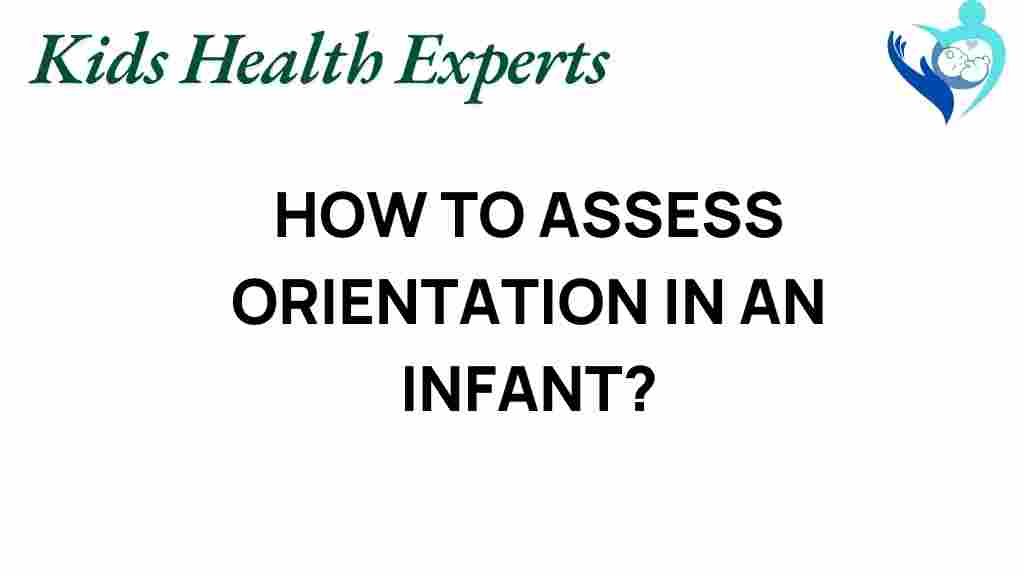Unlocking the Secrets: How to Assess Orientation in an Infant
Understanding infant orientation is crucial for parents and caregivers as it plays a significant role in a child’s overall development. Orientation refers to how an infant perceives and interacts with their environment, which is a key aspect of cognitive skills and developmental milestones. In this article, we will explore ways to assess orientation in an infant, the significance of early assessment, and provide valuable parenting tips to support your baby’s growth.
The Importance of Assessing Infant Orientation
Assessing infant orientation is an integral part of monitoring child development. Infants begin to interact with their surroundings at a very young age, and their ability to orient themselves can indicate their cognitive and physical development. Early assessment can help identify potential developmental delays or concerns, allowing for timely interventions. Here are some reasons why assessing orientation is essential:
- Identifies Developmental Milestones: Understanding an infant’s orientation helps track their progress in reaching critical developmental milestones.
- Enhances Cognitive Skills: Orientation contributes to cognitive skills by allowing infants to explore and learn from their environment.
- Promotes Baby Health: Early identification of orientation issues can lead to better health outcomes through appropriate pediatric care.
- Supports Parenting Efforts: Knowing how to assess orientation can empower parents to provide better support for their child’s development.
Step-by-Step Process to Assess Infant Orientation
To effectively assess orientation in an infant, consider following these steps:
Step 1: Observe Eye Tracking
One of the first signs of orientation in infants is their eye tracking ability. From a young age, infants begin to follow moving objects with their eyes.
- Use a colorful toy or object to capture your infant’s attention.
- Move the object slowly from side to side and observe if your baby follows it with their gaze.
- Note the age at which your infant begins to track objects consistently; this typically occurs around 3 months.
Step 2: Assess Head Movement
As infants grow, they should also demonstrate head movement towards sounds or visual stimuli.
- Make a sound (such as a clap or a rattle) from different directions.
- Watch to see if your baby turns their head towards the sound.
- This ability usually develops around 4 to 6 months of age.
Step 3: Evaluate Reaching and Grasping
As infants become more aware of their surroundings, they begin to reach for objects, which is another indicator of orientation.
- Place a toy just out of reach of your baby.
- Observe if they attempt to reach for it or show interest.
- This skill typically emerges around 5 to 7 months.
Step 4: Monitor Social Interaction
Social orientation is also important. Infants should engage with their caregivers and respond to social cues.
- Smile at your baby and observe if they smile back or engage with you.
- Encourage interaction through games like peek-a-boo.
- Social interaction skills develop around 6 to 9 months.
Step 5: Use Developmental Checklists
Utilizing developmental checklists can help you track your infant’s orientation and other milestones.
- Consult resources from pediatric care providers or trusted parenting websites.
- Regularly check your infant’s progress against established developmental milestones.
Troubleshooting Tips for Parents
If you notice that your infant is not meeting the expected orientation milestones, don’t panic. Here are some troubleshooting tips:
- Stay Calm: Every child develops at their own pace. Some may take a little longer to reach certain milestones.
- Consult a Pediatrician: If you have concerns, schedule an appointment with your pediatrician. They can provide guidance and assess your child’s development.
- Engage in Play: Encourage activities that promote orientation, such as tummy time, reaching games, and interactive play.
- Limit Screen Time: Excessive screen time can hinder an infant’s ability to engage and orient themselves in the real world.
Conclusion
Assessing infant orientation is a vital part of understanding child development. By observing eye tracking, head movements, reaching and grasping, and social interactions, parents can gain insights into their baby’s cognitive skills and developmental milestones. Early assessment can lead to better outcomes in baby health and provide parents with the tools they need to support their child’s growth effectively. Remember, if you have any concerns, do not hesitate to seek advice from pediatric care professionals. For more information on child development, you can visit this helpful resource. Also, check out our parenting tips for more insights on supporting your infant’s growth.
This article is in the category Care and created by KidsHealthExperts Team
